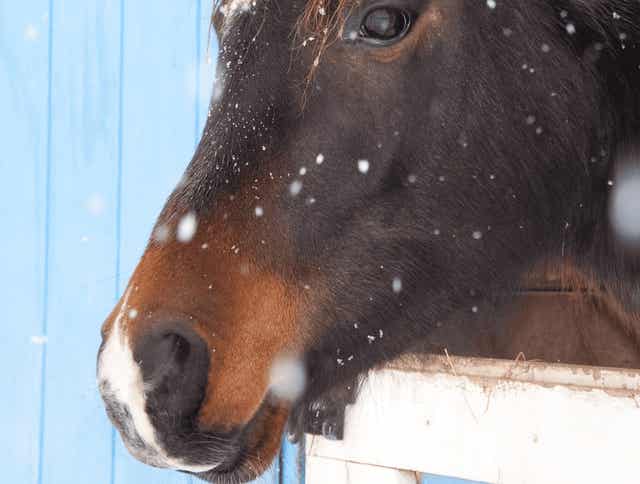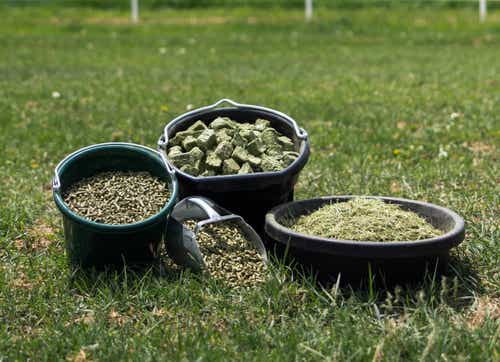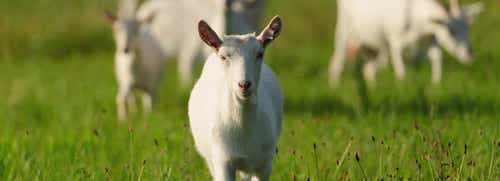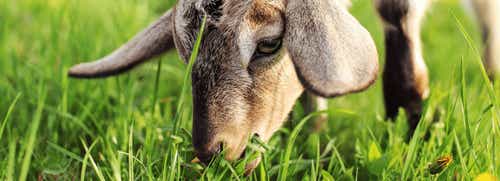
Feeding Horses: What You Need to Know About Forages and Winter
During the winter season, temperatures typically fall below what is necessary for pasture grass to grow. Pastures become rapidly depleted of natural forage and horses must increasingly rely on their owners to provide them with a nutritionally adequate diet. To properly feed a horse during the winter months, several key factors must be addressed. These factors are:
- Water
- Fiber
- Essential nutrients
Water
Water should always be the first consideration in the diet for any horse. Without adequate water intake horses will not survive. An adult horse (1000 lbs.) in a cool, comfortable environment that is not working, or lactating, requires a minimum of 7 - 10 gallons of fresh clean water per day. The amount of water required is closely related to the amount of feed eaten. Most horses will drink 1.5 quarts of water per pound of dry feed intake. If a horse were consuming 20 lbs. of dry hay per day, the horse would be expected to consume approximately 7.5 gallons of water per day.
Water that has frozen or is near freezing will result in decreased intake. Similarly, horses that must eat snow as their only water source, will not eat enough snow to completely satisfy their water requirement. This decreased water intake can result in digestive upset or "colic" that is associated with feed material becoming impacted (stuck) in the digestive system.
Fiber
Adequate fiber intake is the next consideration in feeding horses during the winter season. It is recommended that horses receive a minimum of 1.5% of their body weight in dry hay per day. For a 1000 lb. horse, this equates to 15 lbs. of hay per day. Can horses consume more hay? Certainly, horses can consume up to 3% of their body weight per day in hay (30 lbs. for a 1000-lb. horse), if the hay is of good quality. The fiber obtained from hay is necessary to keep the digestive system of the horse functioning properly. Without this hay fiber, horses will seek out other sources of fiber including bedding and wood fences or trees to satisfy their needs. Adequate fiber from hay is even more critical during the winter months since it is the feed ingredient that keeps horses warm during cold weather. Digestion and fermentation of fiber (hay) produce heat that helps the horse maintain its body temperature during winter. Unlike hay, consumption of grain does not produce large amounts of body heat during digestion. Grain functions to keep horses warm by providing energy for muscle contraction that can be used to help the animal shiver. Therefore, the best way to keep horses warm during cold weather is to provide plenty of good quality hay.
Increase the hay content of the diet 24 hours prior to forecasted cold conditions. Strive to keep your horse in a good body condition prior to winter months, as the extra body fat provides an additional insulating effect against wind and also serves as an energy reserve.
A frequent problem with horses during the winter months is weight loss. This can happen if horses are not being fed enough hay and/or grain or they simply cannot consume enough calories to maintain their condition. Better quality hays are typically higher calorie hays such as alfalfa, compared to grass hay.
If you do not feed enough hay to your horse, it can lead to a variety of issues including:
- Hindgut Acidosis
- Colic
- Gastric Ulcers
- Cribbing
- Wood Chewing (including fences and trees)
- Behavioral Issues
If we assume that the wintery conditions can last for 5 to 6 months, this equates to approximately 150 to 180 days we need to provide hay or hay alternatives to our horses. This equals between 2,250 and 2,700lbs of hay per horse. If you have a boarding operation and have 10 horses, we are now looking at approximately 13 tons of hay. If you house closer to 30 horses, you are looking at 40 tons of hay. If an average small square bale (not compressed) of grass hay weighs approximately 40lbs, you will need about 2025 bales of hay to get 30 horses through the winter!
Storage space for this amount of hay is nearly impossible to find and availability can be scarce. Have you ever thought of substituting some of your hay with a forage pellet?
The key benefits to Standlee Premium Western Forage® bagged forage products include:
- Consistent, high quality products, including Certified Noxious Weed Free options
- Year-round supply
- Easy to haul
- Less storage space
- Easy to feed
- Guaranteed analysis
- Increased digestibility
- Less waste
- Less dust
When managing horses in the winter, we typically close the barn to keep everyone warm. This decreases air circulation and increases the dust, which can lead to more respiratory issues in horses. By including Standlee Premium Western Forage bagged forage products, you can help decrease circulating dust. Wetting the feed and opening the doors during the day will also help minimize dust.
Essential Nutrients
Finally, essential nutrients, providing adequate trace minerals and vitamins is important to maintain adequate immune function and health throughout the winter months. Vitamin E, especially, is very low in most dried forages as it is broken down by light. Standlee Premium Western Forage® has ideal growing and storage conditions, allowing forages to be cut and baled quickly and stored out of the light. This increases the available natural vitamin E in Standlee Forage products. Consult with your veterinarian or contact Standlee to speak with one of our equine nutritionists to assess your horse’s nutrient needs and feed program.
By Dr. Tania Cubitt
Standlee Nutritional Expert - Performance Horse Nutrition







